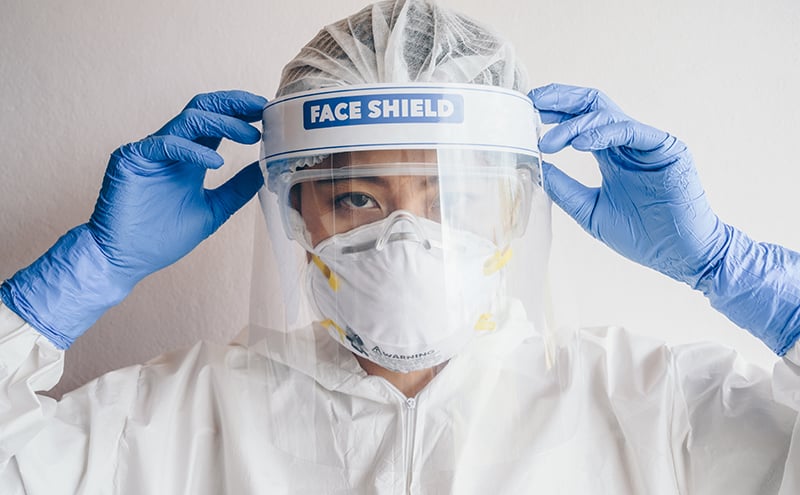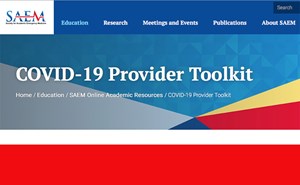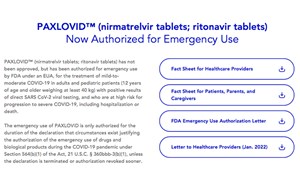The COVID-19 pandemic provided a challenge on a personal, regional, national and international level. It was not even in its distribution, causing hotspots and areas nearly devoid of cases. Communities went from relatively few cases to being overwhelmed with cases in a matter of weeks.
During the summer of 2020, ACEP convened a series of virtual summits which brought together thought leaders in a number of domains to discuss lessons learned from the COVID-19 pandemic response. We compiled a series of lessons learned to prepare for the next pandemic, which can be found online here. This a “playbook” for those communities becoming a hotspot or facing a new pandemic in the future.
To watch the entire 8-hour summit, in one-hour modules, and discover the sources of these recommendations, visit the “Preparing for the Next Pandemic” webpage.
Anticipate becoming a hotspot
The time course of symptomatic Sars-CoV-2 infection starts with a 3-14 day pre-symptomatic phase (mean 5 days) followed by approximately 1 week of illness. In that first week, some patients will develop hypoxia requiring oxygen support. In the second week of illness, some patients will develop severe disease, requiring hospitalization and in some cases, intensive care. Therefore, it is predictable that as testing and initial illness increase, an increase in severe cases can be predicted to occur approximately 1-2 weeks later. In addition, as spread of the disease occurs primarily in pre-symptomatic and asymptomatic individuals, an increase in positive test percentages suggests an increase in hospitalizations approximately 2 weeks later. That increase in cases may continue to grow until public health measures are followed, or until a vaccine is widely available, distributed and people are inoculated.
The best way to anticipate becoming a hotspot is to monitor the results of testing and patient illness in the community.
Prepare to be a hotspot
Central operations and communications:
- Develop or re-assess plans for a central emergency operations center. This center should be composed of hospital administrative and physician leadership including nursing, pharmacy, respiratory therapy, and support services, such as housekeeping and laundry. The center should be manned 24/7 as much as possible. It should receive data from all departments regarding the availability of supplies, workers, and other resources that are necessary for the response. In addition, the center should monitor the physical and emotional well-being of staff. Plans for extreme measures, such as cancelling of elective surgeries and instituting crisis levels of care, should be discussed and measurable targets for action established in advance. Understand that each individual brings a unique knowledge of their area of expertise.
- Create a daily huddle in departments and on patient units to cover topics such as workforce supply and demand, resources available and looming shortages, and bed availability. A daily summary report should be shared with all staff.
- Develop or reassess communication plans. There should be clear, reliable, transparent sharing of data, including resource utilization, from the individual departments and patient care units to the central center and information on the status of the hospital shared with all departments and patient care units.
- Leadership should be present and visible throughout the pandemic. Daily rounding is recommended. Staff must feel free to communicate with leadership without repercussions. Some hospitals have established weekly sessions where staff can vent their frustrations and air concerns.
Staffing:
- Anticipate that patient volumes in the emergency department may decrease in the short term. There may be fewer patients, but the patients will be much sicker and require more care by the staff. As the number of COVID patients decreases, patient volumes should return to near normal. Anticipate that many patients will delay care, resulting in an increase in out-of-hospital deaths, more severe presentation of chronic disease, and more progressive disease progression.
- Anticipate that staffing will be limited, as staff become ill or quarantine. Make plans early to compensate for such individuals to prevent infected staff from continuing to work. Staffing ratios (such as nurse to patient) will be higher as these patients are more complex and require more intensive care. Consider cross training some staff to augment patient care. Pediatric staff can care for many adult patients with appropriate education and consultation. Retired physicians in the community may treat patients with more minor emergencies.
- Ensure that staff needs are addressed. Rest is important, as is time away from the stress of patient care. Institute a buddy system of personal support. Check in with your buddy on a frequent basis.
- Ensure that all patient care staff have been properly trained in donning and doffing of PPE and have developed personal protection plans to ensure the safety of their families.
- Meet with security staff to review or enhance their crowd management skills. In addition, ensure that they have proper PPE and have been trained to don and doff correctly.
Physical Plant:
- Create isolation areas within the emergency department. Determine a flow and division of areas that separates patients with confirmed or suspected COVID from those without evidence or suspicion of disease. Where possible, create negative pressure rooms and cohort infected patients in those areas. Avoid hallway beds and boarding of inpatients.
- Establish infection control measures in the emergency department. Apply social distancing in the waiting room. Limit visitors and in appropriate cases, have patients wait outdoors or in their car to be seen by health care professionals. Mask all individuals including visitors, patients and consultants.
- Review the HVAC capabilities of patient care areas so that appropriate time can be allotted between patients to reduce transmission. Ensure that housekeeping staff have been trained in appropriate decontamination, as well as their own personal protection.
- If appropriate, consider alternate care facilities inside or outside of the facility. Develop plans for augmented post-mortem and mortuary services.
Supplies:
- Anticipate shortages of all supplies and develop plans on how those will be addressed. Assume that tertiary care centers may be at capacity and unable to accept additional patients. Expand your normal transfer ‘list’ to sites further away. If possible, train clerical staff to make the initial phone calls when transferring a patient to another facility.
Patient care:
- Identify vulnerable populations in your community, such as homeless individuals and those with substance use disorders or mental illness, and develop a plan for their care during the pandemic.
- Develop the capability to screen and test staff and patients for illness.
- Establish telemedicine services to connect patients with their primary doctors, ensuring that treatment of chronic conditions continues through the pandemic. Telehealth services can be used to triage patients, perform parts of the patient encounter (e.g. history), and monitor patients after discharge.
External relationships:
- Meet with long-term care facilities, dialysis units, and other ancillary health providers and establish a plan for caring for COVID-positive patients.
- Establish regular communication with the local health department and other external agencies. Where appropriate, involve community alliances, such as the Kiwanis or Lion’s Clubs, religious groups and local media, to provide clear public information. While physicians and other care providers have learned to live with some uncertainty, the general public has not.
Final thoughts:
- Expect that early assumptions will change, as will needs. No one can anticipate everything.
- Anger is a normal reaction and may be directly unfairly to those in charge. The cause of the anger reaction should be examined and corrected, if possible. Anger directed at the pandemic or the response should not be taken personally.
- Encourage vaccination and if possible, facilitate vaccination through the emergency department.
- Finally, hope for the best but prepare for the worst.
After the worst is over
It is well known that depression and guilt follow a crisis, particularly in a small community. It is natural for individuals to feel that they could have done more. Symptoms of PTSD may develop. Sleep disruption is normal. Individuals involved in the response should be prepared to experience these feelings, and also to recognize more severe signs of depression and suicidal ideation. Peer support, battle buddies and other forms of counselling should be available for an extend period of time (up to 1 year).
Written plans for disaster response should be revisited and revised to incorporate the lessons learned during the pandemic.
Retain personal connections with public health agencies, long-term care facilities and other support agencies that assisted in the response. These groups may provide assistance during non-pandemic times.





